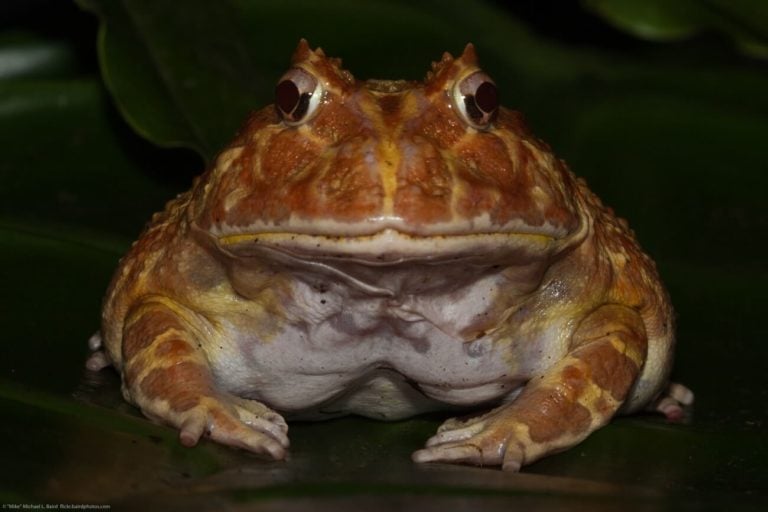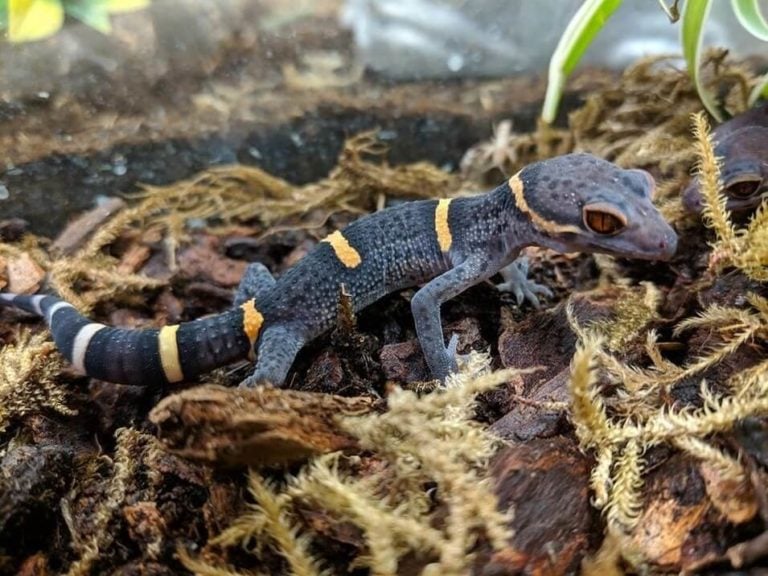The sulcata tortoise is an interesting reptile that’s getting kept as a pet more and more.
The combination of their size, lifespan, and mellow nature has led to this surge in popularity. This is one of our favorite species of tortoise, and we recommend them to anyone (assuming you have the room to keep them).
But before you take the leap into keeping one as a pet, it’s important to have an accurate understanding of their care and habitat requirements. These are very large animals that will only thrive in specific conditions.
This guide will teach you the essential elements of sulcata tortoise care. You’ll learn about what food they eat, how to set up an enclosure, their lifespan, growth rate, and much more!
Table of Contents
Species Summary
Sulcata tortoises (Geochelone sulcata) also known as the African spurred tortoise, are a unique pet tortoise to care for.
They are one of the largest tortoise species in the world and are often seen in zoos and conservatories. Despite this, the sulcata tortoise has also become quite popular in the reptile trade in recent years.
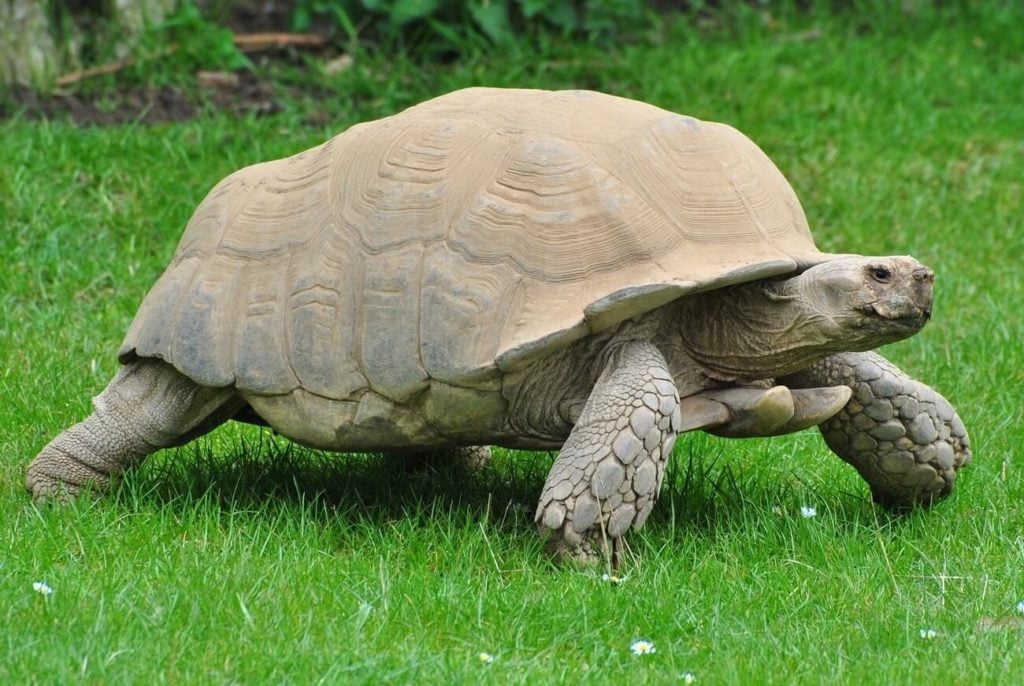
Originally, these tortoises come from East Africa. Wild imports are no longer legal, but these creatures are frequently bred in the southern United States.
They are readily available from breeders and pet stores, which has increased accessibility for reptile owners tremendously.
Like other tortoise species, sulcatas are slow and steady. However, they’re naturally inquisitive and can be a joy to care for.
Contrary to popular belief, you don’t need to live in a specific part of the world to keep these animals healthy. They adapt well to many environments and are often kept in backyards!
Sulcata Tortoise Lifespan
While Sulcata tortoises are appealing for many reptile owners, there’s one factor that you have to consider. These tortoises can live for several decades!
Because captive breeding is still relatively new, the jury is still out on their exact lifespan. Not only that, but there are several factors could affect their overall health.
All that said, it’s believed that healthy sulcata tortoises raised in good conditions can have a lifespan of over 70 years old!
Expert Tip: Their lifespan makes purchasing one as a pet a very serious commitment. If you’re not prepared to keep them for a long time then you’re probably better off with another reptile.
Appearance
Sulcata tortoises are a sight to behold. They are known for having beautiful shells covered in shades of ivory, yellow, and brown.
As newborn hatchlings, most tortoises are very uniform in color. They’re usually ivory with dark brown edges around the scutes of their shell.
Over time, the color of the tortoise can deepen, creating distinct patterns on the shell. The scutes of the shell tend to be rigid and texturized. Older tortoises have visible rings like that of a tree log.
The body of the sulcata tortoise is quite interesting, too. These are land-dwelling creatures that do not swim at all. Thus, their body is equipped to handle the rigors of dry land.
You’ll notice that they have rough armor-like skin on their legs. The legs are large, which provides plenty of strength for the tortoise to move around.
The head is large and contains the same thick skin as the rest of the body. The neck is a bit more delicate. The skin is wrinkly and loose due to the tortoise’s ability to retract under the hood of their shell.
Average Size
The average size of a healthy sulcata tortoise is somewhere between 25 and 30 inches long when fully grown.
As you can see, sulcata tortoises can get very large. But as hatchlings, their carapace measures only about two inches in length!
It’s not uncommon to see tortoises tip the scales at more than 100 pounds. You can expect an adult sulcata to weigh between 80 and 110 pounds.
In the wild, sulcata tortoises have been known to get even bigger. Many specimens have been found to weigh more than 200 pounds! It’s not known yet if captive tortoises have the potential to get that big.
Expert Tip: The interesting thing about sulcata tortoises is that there’s no rhyme or reason for their growth pattern (at least that we know of). Growth rates vary widely across the board, so you can’t use size alone to determine age or health.
Sulcata Tortoise Care
Sulcata tortoise care is fairly low-maintenance when it comes to their temperament. These creatures are known for being very laid-back and will adapt well to a wide range of environments.
However, these animals do have some unique requirements you need to be aware of. Thanks to their massive size, many owners have to get a bit creative when it comes to housing.
Luckily, these tortoises aren’t too fussy. As long as you’re providing the essentials, they should have no problem living long and healthy lives.
Enclosure Size
The biggest obstacle owners face is finding an enclosure that’s large enough for their tortoises as they get bigger.
Small hatchlings can be kept indoors for their first year of life, and do just fine in enclosures that measure 18 inches long, 18 inches wide, and 12 inches tall. This is more than enough room during their first year.
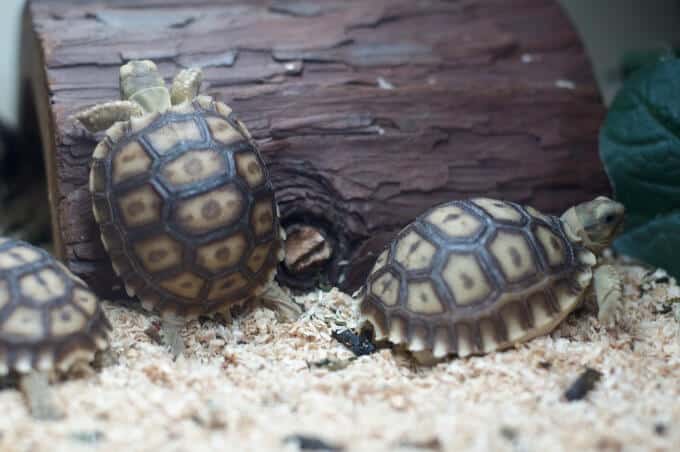
But, they quickly outgrow those smaller environments.
At that point, you must create a large enclosure. If you live in a temperate climate, you can keep sulcata tortoises outdoors.
Most owners of adult sulcatas create a large outdoor enclosure with a desert-like setup. The key here is to provide ample room to roam.
These tortoises love to explore, so a large outdoor enclosure is a must.
The enclosure should have durable walls that are at least 24 inches high. Concrete walls are preferred, as these animals are strong enough to blow through standard wooden fences. The fence should be solid with no visibility through the walls.
The walls should extend below the surface of the ground to prevent digging. Placing concrete 12 to 24 inches below the surface is recommended.
Expert Tip: A uniform covering over the enclosure isn’t necessary. However, it’s important to protect your tortoises from natural predators.
If you need more security, you can extend the fence with chainlink or wood above the fence line.
What To Put In Their Habitat
With a large outdoor enclosure, you have a lot of opportunities to create an enjoyable environment. The best thing you can do is recreate that desert environment of their natural habitat.
The bottom of the enclosure can be left as bare dirt. These tortoises are grazers, so grass and delicate plants are usually ruined pretty quickly.
Standard dirt or sand is great for sulcata tortoises. They can easily dig and create a burrow whenever they need protection from the sun.
You can plant various desert plants around the enclosure. Just make sure that they’re tough. Mesquite and African Sumac trees are popular options. If possible, plant some mature trees to provide ample shade during hot afternoons.
Houses are essential, too. Large dog houses or custom-made caves work well. It’s best to utilize insulated houses to provide a warm space for the tortoise when it gets cool.
Make sure that the house is raised off the ground and has a large ramp to help the tortoise get in. Sliding doors for easy cleaning are a good choice as well.
Temperature & Lighting
Sulcata tortoises do well in various temperature ranges. Ideally, daytime temperatures will be between 68 and 80 degrees Fahrenheit.
However, these animals can tolerate temperatures well over 100 degrees. As long as they have shade and a house to go into for shelter, they’ll have no problems.
The same goes for low nighttime temperatures. They are most comfortable at 70 degrees or above during the night.
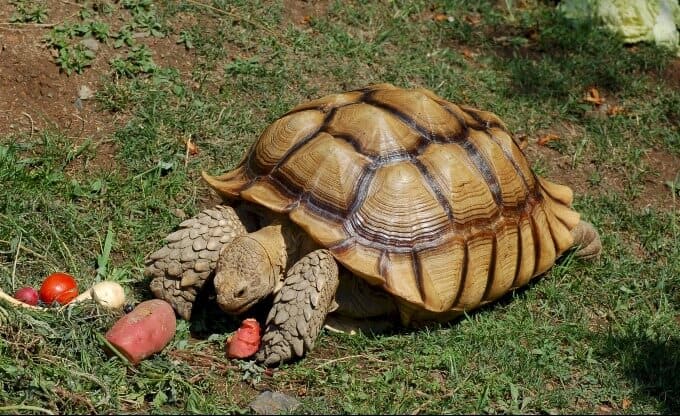
If it gets lower than that in your area, you’ll need to provide supplemental warmth in their home.
You can install radiant heat maps on the roof or floor of the home. Avoid using heat emitters or lamps though, since they could create a fire hazard.
Sulcata tortoises that are kept outdoors will not need a UVB lamp. However, if you keep yours inside the home or in a dedicated indoor enclosure, such as a shed, it is necessary.
UVB rays are essential because it helps the tortoise process calcium. If needed, use UVB lamps to light up the indoor enclosure for 12 to 14 hours a day.
You can also use supplemental lights to create hotter basking areas that are in the 100-degree range.
Humidity
When it comes to humidity sulcata tortoises need moderate humidity levels. Their environment should have between 45 and 50 percent humidity.
Humidity is essential for hydration and keeps the shell in good condition. Without enough humidity, the shell can become brittle and cracked. You’ll often find tortoises burrowing to take advantage of in-ground moisture to overcome that issue.
However, you need to make sure that there isn’t too much humidity either. This could lead to respiratory infections. Invest in a hygrometer and measure the environment regularly.
Expert Tip: You can raise humidity levels easily by misting the habitat. This applies to both indoor and outdoor environments.
Water
Access to fresh water is crucial, and can be provided with some large shallow water dishes. Make sure that the dishes are not deep enough to drown the tortoise or topple over if they climb in!
Sulcata tortoises like to soak in their dishes. However, during this time they will often defecate. This means you’ll need to monitor the dish and clean it out regularly.
If kept outside, you can also create mud holes. Simply soak a portion of the dirt so that the tortoise can climb in and rehydrate.
They will drink from plant leaves and muddles. But soaking is how sulcata tortoises stay hydrated.
You can give your tortoise a good spray with water every once in a while for a boost of hydration during the hotter months.
Sulcata Tortoise Food & Diet List
Sulcata tortoises are herbivores that need a diet that’s very low in protein. Too much high-protein food can cause gastrointestinal problems as well as serious shell deformities.
Plant-based diets that are high in fiber are preferred. Luckily, you won’t have any issues finding something your tortoise enjoys!
These animals accept a wide range of foods. Here are some good foods to provide:
- Grass hay
- Clover
- Dandelion
- Corn
- Cactus paddles
- Mulberry leaves
- Squash
- Turnip greens
- Endive
- Romaine lettuce
- Sow thistle
- Chard
- Pumpkin
- Grape leaves
A good mix of grasses and greens are great foods for sulcata tortoises. Just avoid anything high in protein or greens that have a lot of calcium, and you should be fine.
To ensure that the tortoise is getting all the vitamins, nutrients, and fiber they need, add a lot of variety to their meals. Mix things up and introduce different foods into their diet rather than sticking to one thing.
Sulcata tortoises will naturally scavenge for grasses in the environment. You can provide meals every other day. However, hatchlings will need to eat daily.
Potential Health Issues
Sulcata tortoises are susceptible to many of the same diseases that other reptiles are. This includes respiratory infections and metabolic bone disease.
Respiratory infections can be identified by inflammation around the nose and mouth. It’s most commonly caused by too much moisture in the air and environment. While moisture is important, you’ll need to keep those humidity levels under control.
Metabolic bone disease is a serious issue that’s caused by a lack of exposure to UVB rays. This isn’t a problem with tortoises kept outdoors. But those that are sheltered from the sun’s rays will need a UVB lamp.
You can also utilize supplements to ensure that your tortoise is getting the Vitamin D they need to process calcium accordingly.
Expert Tip: Other common health issues include fungal infections and shell rot. If you encounter these problems, consult with a veterinarian. Most health issues are easily treated.
Behavior & Temperament
Despite their large size and slow speeds, sulcata tortoises are naturally inquisitive. They really enjoy roaming around their environment, and you will often see these animals walking around the perimeter of the enclosure or searching for food.
When they’re not doing that, they may burrow in the dirt. These animals are powerful diggers and will often cover themselves with dirt when they want to cool down. This is especially true if the dirt is moist.
Thanks to their curiosity, you have to be extra careful about obstacles in the environment. Remove anything that the tortoise can climb on. They are prone to toppling over.
Unfortunately, these animals are virtually helpless once they have been flipped on their back. They can suffocate in this position, so make sure that you make their habitat as topple-proof as possible!
Handling
Flipping the tortoise over should be the only time you handle them. These animals do not like being held. Even as babies, it’s a stressful event.
Avoid pinning the tortoise down or restricting their movement in any way. Adult sulcatas can get comfortable in the presence of humans, but too much handling will still make them anxious.
This could lead to some health issues, so it’s best to let the tortoise do its own thing.
Still Interested?
Now that you have an accurate understanding of what’s required to provide excellent sulcata tortoise care, it’s time for you to think about if this species is right for you.
Everything about their temperament, diet, and daily requirements can be handled by pretty much anyone (no matter how much experience you have).
But these reptiles need plenty of space.
If you’re unable to provide them with a large enclosure, it’s a dealbreaker. Both you and your tortoise will be better off waiting until you have the room to keep them.
However, if you have the room we say go for it! These animals are fantastic pets and incredibly rewarding to own. The bond you’ll form with them over their long lifespan is something that can only be matched by a few other animals!
If you want to learn a bit more about this species we’re always happy to chat. We love talking to our readers, and never mind taking the time to provide some extra insight.

